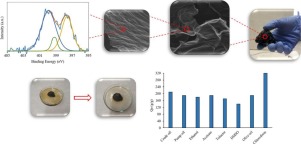当前位置:
X-MOL 学术
›
J. Ind. Eng. Chem.
›
论文详情
Our official English website, www.x-mol.net, welcomes your
feedback! (Note: you will need to create a separate account there.)
N-doped reduced graphene oxide aerogel for the selective adsorption of oil pollutants from water: Isotherm and kinetic study
Journal of Industrial and Engineering Chemistry ( IF 5.9 ) Pub Date : 2018-05-01 , DOI: 10.1016/j.jiec.2017.12.041 Zahra Rahmani , Ali Morad Rashidi , Abbass kazemi , Mohhammad Taghi Samadi , Ali Reza Rahmani
Journal of Industrial and Engineering Chemistry ( IF 5.9 ) Pub Date : 2018-05-01 , DOI: 10.1016/j.jiec.2017.12.041 Zahra Rahmani , Ali Morad Rashidi , Abbass kazemi , Mohhammad Taghi Samadi , Ali Reza Rahmani

|
Abstract N-doped graphene aerogel with a 3D inter-connected network was synthesized using graphene oxide and pyrrole in an aqueous medium with ammonia. Hydrothermal and thermal annealing methods were employed to do it so. The structure and surface properties of the synthesized aerogel were characterized using Fourier Transform Infrared (FTIR) spectroscopy, X-ray Diffraction (XRD), Raman spectroscopy, Field Emission Scanning Electron Microscopy (FE-SEM), XPS, and nitrogen adsorption/desorption measurements. The prepared n-doped aerogel exhibited elevated specific surface area (340 m2/g), hydrophobic nature, and excellent adsorption capacity (210 g/g for crude oil removal). Adsorbent recyclability was also investigated; it is worth noting that after ten subsequent cycles, only just a negligible decrement in adsorption capacity was observed. Furthermore, the effect of salts and temperature on adsorption capacity was studied. Isotherm and kinetic studies were last examined. The conformity of various adsorption models, including Freundlich, Langmuir, Temkin, and Dubinin–Radushkevich (D–R) to the equilibrium data was evaluated among which Langmuir isotherm model gave the best fitting result. The sorption kinetics data were well described by the pseudo-second-order kinetic model. As a consequence, oil spills adsorption using n-doped graphene aerogel is a relatively cost-effective method which can be scaled up, and it could be a promising material for removal of organic contaminants from water.
中文翻译:

N掺杂还原氧化石墨烯气凝胶用于选择性吸附水中油类污染物:等温线和动力学研究
摘要 使用氧化石墨烯和吡咯在含有氨的水性介质中合成了具有 3D 互连网络的 N 掺杂石墨烯气凝胶。为此采用了水热和热退火方法。合成气凝胶的结构和表面性质使用傅里叶变换红外 (FTIR) 光谱、X 射线衍射 (XRD)、拉曼光谱、场发射扫描电子显微镜 (FE-SEM)、XPS 和氮吸附/解吸测量进行表征. 制备的 n 掺杂气凝胶表现出较高的比表面积(340 m2/g)、疏水性和优异的吸附能力(去除原油为 210 g/g)。还研究了吸附剂的可回收性;值得注意的是,在随后的 10 个循环之后,仅观察到吸附容量的下降可忽略不计。此外,研究了盐和温度对吸附容量的影响。最后检查等温线和动力学研究。评估了各种吸附模型,包括 Freundlich、Langmuir、Temkin 和 Dubinin-Radushkevich (D-R) 与平衡数据的一致性,其中 Langmuir 等温线模型给出了最好的拟合结果。吸附动力学数据由拟二级动力学模型很好地描述。因此,使用 n 掺杂石墨烯气凝胶吸附溢油是一种相对具有成本效益的方法,可以扩大规模,并且它可能是一种从水中去除有机污染物的有前途的材料。Langmuir、Temkin 和 Dubinin-Radushkevich (D-R) 对平衡数据进行了评估,其中 Langmuir 等温线模型给出了最佳拟合结果。吸附动力学数据由拟二级动力学模型很好地描述。因此,使用 n 掺杂石墨烯气凝胶吸附溢油是一种相对具有成本效益的方法,可以扩大规模,并且它可能是去除水中有机污染物的有前途的材料。Langmuir、Temkin 和 Dubinin-Radushkevich (D-R) 对平衡数据进行了评估,其中 Langmuir 等温线模型给出了最佳拟合结果。吸附动力学数据由拟二级动力学模型很好地描述。因此,使用 n 掺杂石墨烯气凝胶吸附溢油是一种相对具有成本效益的方法,可以扩大规模,并且它可能是一种从水中去除有机污染物的有前途的材料。
更新日期:2018-05-01
中文翻译:

N掺杂还原氧化石墨烯气凝胶用于选择性吸附水中油类污染物:等温线和动力学研究
摘要 使用氧化石墨烯和吡咯在含有氨的水性介质中合成了具有 3D 互连网络的 N 掺杂石墨烯气凝胶。为此采用了水热和热退火方法。合成气凝胶的结构和表面性质使用傅里叶变换红外 (FTIR) 光谱、X 射线衍射 (XRD)、拉曼光谱、场发射扫描电子显微镜 (FE-SEM)、XPS 和氮吸附/解吸测量进行表征. 制备的 n 掺杂气凝胶表现出较高的比表面积(340 m2/g)、疏水性和优异的吸附能力(去除原油为 210 g/g)。还研究了吸附剂的可回收性;值得注意的是,在随后的 10 个循环之后,仅观察到吸附容量的下降可忽略不计。此外,研究了盐和温度对吸附容量的影响。最后检查等温线和动力学研究。评估了各种吸附模型,包括 Freundlich、Langmuir、Temkin 和 Dubinin-Radushkevich (D-R) 与平衡数据的一致性,其中 Langmuir 等温线模型给出了最好的拟合结果。吸附动力学数据由拟二级动力学模型很好地描述。因此,使用 n 掺杂石墨烯气凝胶吸附溢油是一种相对具有成本效益的方法,可以扩大规模,并且它可能是一种从水中去除有机污染物的有前途的材料。Langmuir、Temkin 和 Dubinin-Radushkevich (D-R) 对平衡数据进行了评估,其中 Langmuir 等温线模型给出了最佳拟合结果。吸附动力学数据由拟二级动力学模型很好地描述。因此,使用 n 掺杂石墨烯气凝胶吸附溢油是一种相对具有成本效益的方法,可以扩大规模,并且它可能是去除水中有机污染物的有前途的材料。Langmuir、Temkin 和 Dubinin-Radushkevich (D-R) 对平衡数据进行了评估,其中 Langmuir 等温线模型给出了最佳拟合结果。吸附动力学数据由拟二级动力学模型很好地描述。因此,使用 n 掺杂石墨烯气凝胶吸附溢油是一种相对具有成本效益的方法,可以扩大规模,并且它可能是一种从水中去除有机污染物的有前途的材料。











































 京公网安备 11010802027423号
京公网安备 11010802027423号